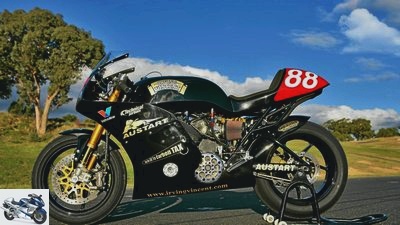Menus

Piper
Test Irving Vincent 1600 V8
Homemade from Australia
Content of
V-Twin, air-cooled, 1600 cubic meters, eight valves – the self-made from Australia is a real bomb. This is also underlined by the performance data of this unique item.
It is a mixture of a brutal racer and an almost antique engine concept. The Irving was invented VIncent 1600 V8 from the Australian Horner brothers Ken and Barry to scare the twin superbikes at the ProTwin races in Daytona 2013. The name of the bike is a deep tribute to Phil Irving, the Australian engineer of the British Vincent motorcycle manufacturer, who went bankrupt in 1955, was successful in Formula 1 from the 1960s and later taught the Horner boys near Melbourne a lot. “Phil was great and we wanted to build a competitive racer without using ultra-modern technology,” Ken explains the concept. “Actually, we would need an airbox and water cooling, but that would completely destroy the dignity of this 50-degree twin.”
In Daytona in 2008, they already demonstrated that the Aussies know their craft. With the 1300 – Irving Vincent Ahnin – driver Craig McMartin beat the factory Ducatis. Back then it was around 1098, in 2013 they will face Panigale. The 142 hp would not have been enough for that. So they increased the twin with a bore of almost 100 millimeters to a miserably long 100 millimeter stroke and thus to 1571 cc. But the 165 hp achieved with it still seemed too scarce to them. So the brothers went to work on the cylinder head, now giving the former two-valve engine four per cylinder. “Around the top we just reached the end of the flagpole. We implemented some of Phil’s ideas and now have eight valves without overhead camshafts, ”explains Barry, without giving away the details. With a compression of 13: 1, the Irving Vincent now has a whopping 186 hp at 6800 rpm – and weighs only 180 kilos without fuel. But the torque is even more breathtaking: at 5800 rpm the black bomber pushes with 193 Nm. A major design problem, however, was the heat – no wonder with an air cooler with this performance. “The longer it ran on the test bench, the more you could watch the performance decrease,” said Ken. “We had to redesign the entire oil circuit so that more oil could circulate and we could get a better grip on the temperature.” Nonetheless, the engine heat initially caused valve problems. Special outlet valves made from a heat-resistant Inconel alloy provided a remedy.
Piper
Irving Vincent 1600 V8.
The racer with a central tubular frame made of chrome-molybdenum steel, tubular swing arm, a state-of-the-art 43 mm JR900 fork from Ohlins and the TTX36 shock absorber distributes its weight 52 to 48% (front / rear).
While driving, the revving pleasure of the huge twin is astonishing, delivering astonishingly little torque in relation to its cubic capacity. You have to keep it well above 3500 rpm, but then shoot out of the corners like a cannonball.
The braking stability is downright clear. Without an anti-hopping clutch, the braking torque is of course enormous due to the twin size alone. But when the clutch is carefully engaged, there is no risk of punching the rear wheel, which hardly lifts off the piste even when anchored hard. So it is important to set the braking points a little earlier, to take some time when downshifting and then to steer in with force. Driving the Irving Vincent 1600 V8 is very special, but an unforgettable experience in a positive sense. The little, half-disguised sister achieved a top speed of 266 km / h in Daytona. With full fairing, the 1600 series should go up another 18 km / h. Then in 2013 we will see if the retro-oriented racer can pack the high-tech Panigale in Daytona.
Related articles
-
Comparison test Harley-Davidson Road King Classic against Yamaha XV 1600 Wildstar
Comparison test Harley-Davidson Road King Classic against Yamaha XV 1600 Wildstar IG Metall Hard times for Harley-Davidson. In Heayv’s tariff poker …
-
BMW K 1600 excavator in the test
bilski-fotografie.de 16 photos bilski-fotografie.de 1/16 BMW K 1600 B. bilski-fotografie.de 2/16 If the window is up, there is almost no wind. This is…
-
Luxury tourer comparison test BMW K 1600 Grand America and Honda GL 1800 Gold Wing Tour DCT airbag
17 pictures 1/17 BMW K 1600 Grand America and Honda GL 1800 Gold Wing Tour DCT airbag in comparison test. 2/17 …
-
Cruiser comparison test: Honda VTX 1300 S, Kawasaki VN 1600 Classic
Cruiser comparison test: Honda VTX 1300 S, Kawasaki VN 1600 Classic Damn long and heavy Handy six-centimeter chunks, wheelbases begging for parking bay, …
-
BMW K 1600 GT Sport and BMW R 1200 RT in comparison test
Bilski 37 photos Bilski 1/37 The renewed strut of the RT could respond better, spring and dampen finer. And there are top tourers with more reserves….
-
Endurance test Yamaha XV 1600 A Wild Star
Bilski long-term test Yamaha XV 1600 A Wild Star Difficult in order Good things take time. The six and a half quintals cruiser took three years to …
-
Cafe racers in the comparison test
29 pictures 1/29 Whether you call it retro, vintage or heritage, pleasure-oriented driving without horsepower is back in. …
-
Test, Yamaha TDM 850 Yamaha DTM 850 Heavily revised, the Yamaha TDM 850 should finally become a big winner five years after its market launch. Some…
-
Top test Moto Guzzi 1200 Sport 4V
fact Top test, Moto Guzzi 1200 Sport Moto Guzzi 1200 Sport 4V Moto Guzzi hasn’t just been in crisis since the crisis. In the identity crisis. Classic or…
-
Test: Triumph Rocket III Roadster
Bilski Test: triumph Triumph Rocket III Roadster More power, more torque, better brakes and a more martial appearance for less money: The Triumph press…